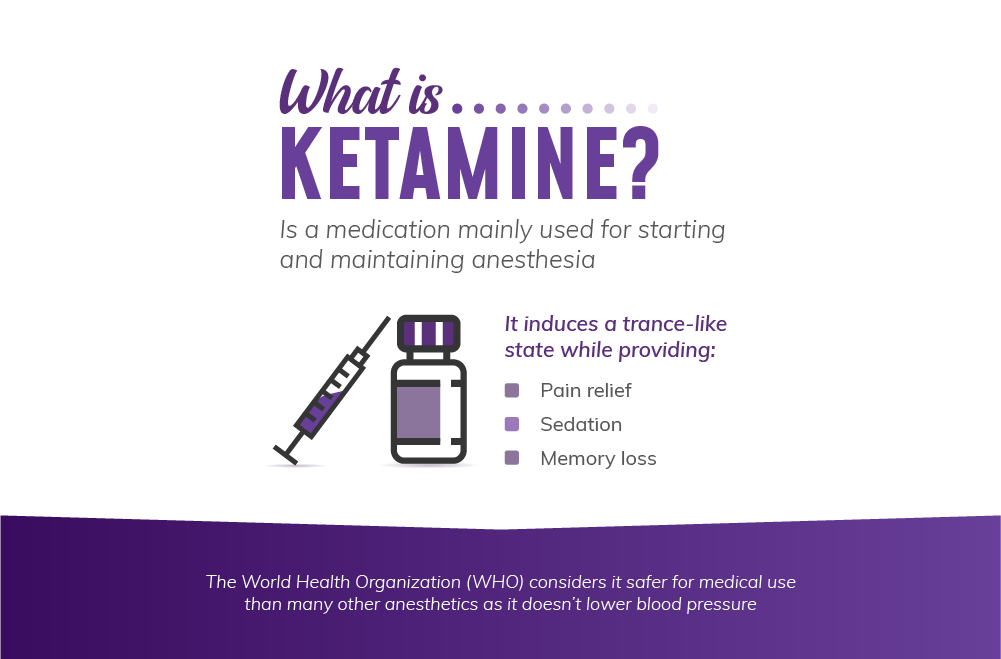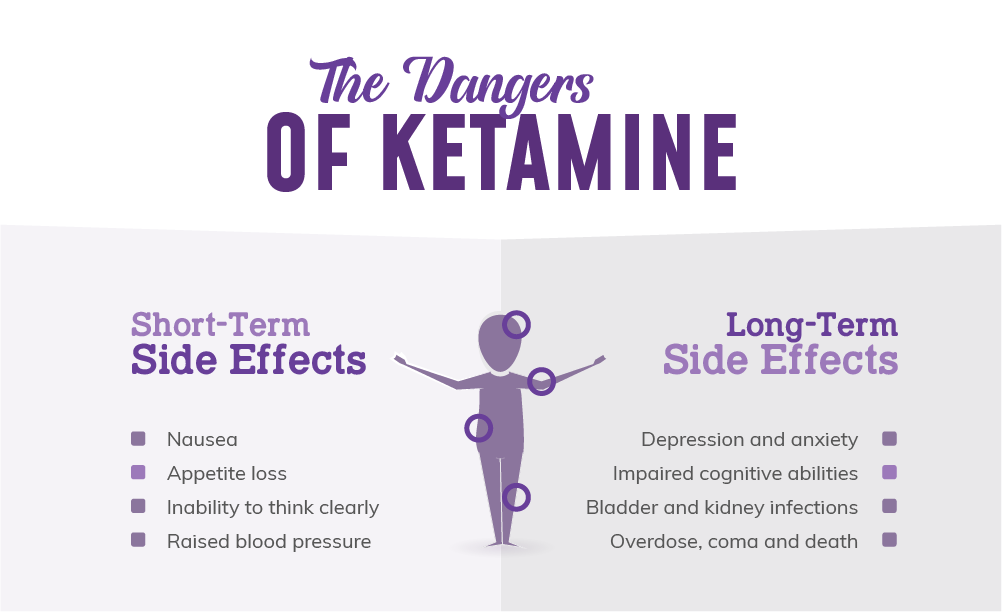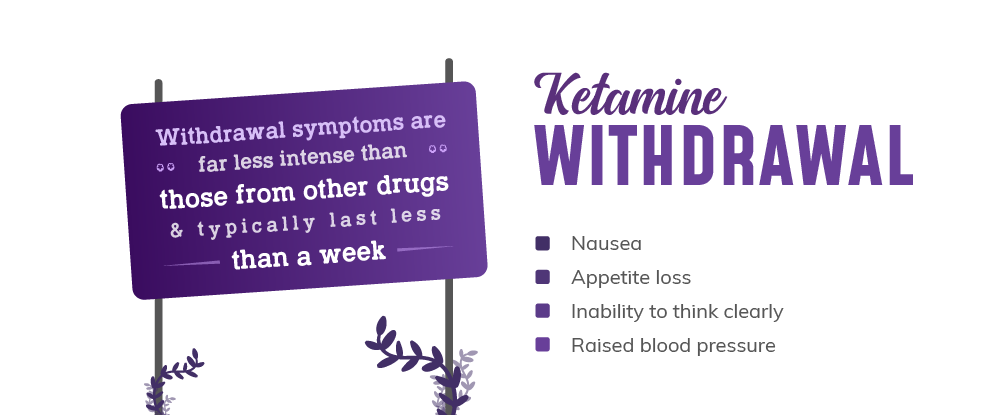Ketamine is one of the most commonly abused party drugs. Habit-forming and easily abused, it’s popular among recreational drug users— especially young people. Recreational use of this drug may be growing in popularity, but that doesn’t change the fact that taking ketamine carries a high risk. Alarmingly, many users are unaware of the dangers. So why are people so addicted to ketamine? Read on and find out why it’s abused:
“We treat both addiction and co-occurring disorders and accept many health insurance plans. Take a look at our outpatient rehab program.”
What Is Ketamine?
You might have heard ketamine referred to as a horse tranquilizer. But if you’ve ever had surgery under general anesthetic, then chances are you’ve actually taken ketamine yourself. Often sold under the brand Ketalar, ketamine is an NMDA receptor antagonist. It’s classified as a dissociative and is traditionally administered as a sedative during medical procedures. The World Health Organization considers it safer for medical use than many other anesthetics as it doesn’t lower blood pressure. While it was originally used in veterinary clinics in the 1970s, it’s now given to both humans and animals. It’s administered to patients either intravenously or via a nasal spray. 
- Pain management
- Sedation, especially for children and patients with low blood pressure
Trials are also currently underway to determine the therapeutic potential of ketamine as a treatment for depression. Of course, there’s one more increasingly common (but far more illicit) way that ketamine is used: recreationally.
Ketamine As A Party Drug
Ketamine’s many street names — Ket, Special K, Vitamin K, or simply “K” — didn’t come from hospitals, but from those who choose to use it as a party drug. 
How long does ketamine last?
Unlike other party drugs, such as MDMA, the intense ketamine high is relatively short— around 25 to 90 minutes. It produces a powerful and often hallucinogenic high. The effects of a ketamine high include:
- Feeling disoriented and confused
- Disconnection from environment
- Numbness and loss of physical sensation in the body
- Psychedelic effects, such as hallucinations
- Tingling in limbs
- A sense of euphoria
- Double vision
- Affected speech
- Drooling
These strong effects have also lead to ketamine being used as a date rape drug. It is virtually undetectable by taste or sight when dissolved in a drink.
What Is A “K-Hole?”
High doses of ketamine can cause the user to suffer what is known as a “K-hole”. This is basically a strong psychedelic episode that causes a complete sense of dissociation. When in a K-hole, the user may feel completely disconnected from their physical body and surroundings. They can even feel as if they’re literally in a dark hole, unable to get out. It can be difficult or even impossible to perceive time passing. Hallucinations are a common occurrence in the K-hole. 
“Get your loved one the help they need. We provide outpatient addiction treatment in Denver and Summit County, see more here.”
What Are The Dangers Of Ketamine?
While ketamine is considered to be relatively safe in a medical context, it carries many risks when taken recreationally. Some of the short-term side effects of taking ketamine are:
- Nausea
- Raised blood pressure
- Inability to think clearly
- Appetite loss

- Affected cognitive abilities, such as memory
- Nasal infections from snorting powder
- Bladder and kidney infections
- Depression and anxiety
- Overdose, coma and death
Bladder issues are common among ketamine users, especially those who snort it. Trace amounts of ketamine can enter the digestive system and damage the bladder, causing serious long-term health issues. This condition has become so prevalent that it’s been dubbed “K Bladder”. K Bladder (proper name ketamine cystitis, or ketamine bladder syndrome) can cause permanent organ damage. This can cause the following symptoms:
- Difficulty urinating
- Painful urination
- Kidney and urinary tract infections
- Severe abdominal cramps
- Passing blood through the urethra
Some sufferers of K Bladder have to get their bladders surgically stretched, or even removed entirely. For this reason, swallowing ketamine orally can be very harmful. Since ketamine is an anesthetic, users put themselves at greater risk of physical injury thanks to a reduced loss of sensation in their body. Someone high on ketamine may not even realize they’ve injured themselves. The way that ketamine is taken can also cause further health problems. Snorting powdered ketamine can lead to infections and even necrosis inside the nostrils. Injecting any drug, including ketamine, involves a risk of blood borne diseases such as HIV or Hepatitis C if needles are shared. Like many illegal drugs, ketamine use can lead to overdose and even death. In countries like the UK, where ketamine abuse is far from uncommon, many young addicts have died from the numerous health complications of their addiction.
Taking Ketamine When You Have A Medical Condition
Taking illegal drugs always carries a health risk, but especially if you have a pre-existing medical condition.
Diabetes And Ketamine
Diabetics (especially those with type 1 diabetes) are at high risk of developing ketoacidosis. This is a life-threatening condition caused by elevated blood sugar and ketones in the body. It is the number one cause of death among young diabetics. How does ketamine affect diabetics? Some research suggests that ketamine can actually increase the risk of ketoacidosis. This is because it affects the body’s glucose response and tolerance.
Ketamine And Blood Pressure
Ketamine is also known to raise blood pressure immediately after consumption, which can pose a high risk to those with heart conditions or hypotension (high blood pressure).
Mixing Ketamine With Other Substances
Ketamine is a depressant, which means it doesn’t mix well with other substances— especially other depressants. The combination can cause respiratory issues, which can lead to suffocation and death. Other common depressants include:
It’s also unwise to combine ketamine with stimulants, as ketamine elevates blood pressure. The combination can also cause anxiety or even psychotic episodes.
What’s Really In Your Ketamine?
One of the biggest risks of taking ketamine recreationally is the danger of not actually taking ketamine at all. Similar street drugs are often passed off as ketamine when sold illegally, unbeknownst to the buyer. Some of the most common substitute drugs are:
- Procaine, an anesthetic (also known as Nocavain)
- PMMA, a powerful psychedelic and analog of methamphetamine
- Methoxetamine (MXE), a highly potent dissociative
- Fentanyl, an opioid 10,000 times more potent than morphine.
These drugs can have completely different side effects and risks to ketamine, which can pose great danger to the user. Of all these examples, Fentanyl is by far the most concerning. The smallest amount of this substance carries an extremely high risk of death. Just a few specks of Fentanyl can kill. Illegal drug manufacturers often cut ketamine with these substances, making it impossible for users to detect by inspection or ingestion. All too often, the user has no idea if what they’re taking is actually ketamine until it’s too late. This is a common scenario at events such as music festivals that fail to provide drug-testing facilities.
How Is Ketamine Similar To PCP?
The effects of ketamine are sometimes compared to another dissociative: PCP (Phencyclidine), or “angel dust”. Ketamine was actually developed as an alternative to PCP, which was once also used as a sedative in hospitals. PCP and ketamine can produce similar hallucinogenic effects. But unlike ketamine, PCP’s effects are long lasting, and can even include psychosis— which is exactly why it’s no longer used in hospitals. Unfortunately, ketamine’s predecessor is still abused illegally.
Is Ketamine Actually Addictive?
If there’s one thing ketamine proves, it’s that there’s more to drug addiction than physical cravings. As ketamine is easily binged, it’s all too easy to form a mental dependency on it. To understand how ketamine addiction works, it’s important to understand how and why it’s abused in the first place. The body builds a tolerance to ketamine quite quickly. This means that the user must take larger doses each time to get the same high, which makes ketamine highly habit-forming. Of course, no one plans on becoming addicted to ketamine. But casual use can easily become more frequent, leading to a dangerous and very expensive habit. 
How Can You Tell If Someone Is On Ketamine?
Since ketamine produces such strong effects, it’s often difficult for users to conceal the fact that they’ve taken it. Telltale signs of ketamine use include:
- Traces of powder around the nostrils or needle marks on body
- Slurred speech
- Difficulty focusing gaze
- A “zombie-like” walk
- Inability to control limbs and movement
- Difficulty concentrating and responding to others
- Dilated pupils
How To Get Help For Ketamine Abuse
Are you concerned that a loved one may be abusing ketamine? Are you worried about your own habit? First of all, there’s good news. Ketamine withdrawal is far less intense in comparison to other addictive substances, and typically lasts less than a week. Withdrawal symptoms can include:
- Fluctuating body temperature (such as chills and sweating)
- Restlessness or low energy levels
- Disturbed sleep and nightmares
- Elevated heartbeat and breathing, similar to the physical sensation of anxiety
Users who decide to overcome their ketamine addiction are at high risk of developing depression and anxiety in the long-term. It’s important to seek out a program that offers both addiction treatment and therapy during this time. Ketamine might seem like an exciting party drug, but its many side effects are far from fun. The high risk of health complications can stem from not only regular use but also casual experimentation. Don’t become another tragic statistic. It’s never too late to take charge of your life and overcome your ketamine addiction.
Full Infographic:
Sources:
National Institute of Drug Abuse https://www.drugabuse.gov/sites/default/files/clubdrugs10.pdf NYC Health http://www1.nyc.gov/site/doh/about/press/pr2017/pr043-17.page Office on Women’s Health https://www.womenshealth.gov/a-z-topics/date-rape-drugs World Health Organization http://www.who.int/medicines/news/20160309_FactFile_Ketamine.pdf National Drug Intelligence Center https://www.justice.gov/archive/ndic/pubs4/4769/4769p.pdf Nursing Times https://www.nursingtimes.net/clinical-archive/medicine-management/addressing-ketamine-bladder-syndrome/5031324.article Vice https://www.vice.com/sv/article/av4njj/ketamine-slowly-ruins-your-bladder-and-kills-you-863 Health Line http://www.healthline.com/health/ketosis-vs-ketoacidosis








